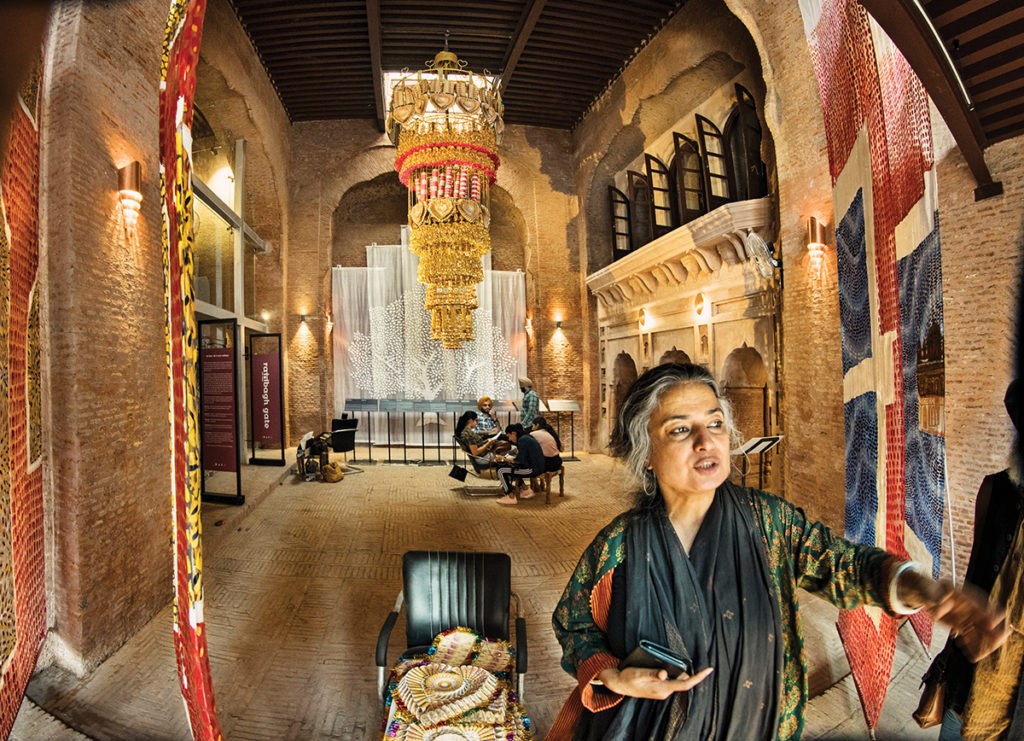In Conversation with Gurmeet S. Rai
June 19, 2023
Gurmeet S. Rai is a conservation architect who can be credited with the conservation of some of the most famous built heritage projects in India. There, she started the Cultural Resource Conservation Initiative in 1996, a conservation consultancy firm that works on cultural heritage conservation and management practices locally. Rai has been a specialist consultant to several UNESCO workshops in Asia Pacific and is currently the Vice President of the International Council on Monuments and Sites (ICOMOS) India and an expert, voting member on the International Scientific Committee on Cultural Tourism. She spoke to Bhawna Jaimini about the role of conservation in the face of the climate crisis, the need to reform planning institutions and how the current political climate of India does not faze her one bit because heritage is more than just material culture.

BJ: Considering the ongoing climate crisis, we need to build less and conserve more. In Mumbai where I am, low-rise buildings and bungalows from the Art Deco era are getting razed every day in favour of high-rise towers because a) there is little awareness on preserving and conserving in the built environment sector, and b) there is economic pressure on landowners to make the most of their land. In such a scenario, how can conservation practices become more mainstream?
GSR: I would like to start with the fact that now the conservation discourse has moved forward to look at Nature and culture together. This was not how it was looked at a few decades ago.
The discourse around preserving and saving the built heritage became strong after World War II when countries were bombing each other and Europe had lost a lot of its built heritage. There was a lot of debate around how to rebuild what was lost, in terms of what to reinstate and what to let off—in terms of materiality, authenticity of style and so on. And thus, UNESCO was set up as the world body that is at the forefront of worldwide conservation practices and policies.

UNESCO has three advisory bodies: the International Union for Conservation of Nature (IUCN), ICOMOS and the International Centre for the Study of the Preservation and Restoration of Cultural Property (ICCROM). All these bodies have representation from all the countries and work independently—for example, IUCN has its members, government organisations and scientists, and ICOMOS is mostly practitioners working in the sphere of cultural heritage from all the member states.
In the last five years, a working group has been established from an understanding that IUCN and ICOMOS need to collaborate and this initiative is called Nature and Culture, Connecting Practice. This is a huge development at the international level. However, at the national level in India, there is a lot that needs to be done to make conservation practices more mainstream. We have multiple laws, acts and bodies that govern the sphere of natural heritage, but when it comes to cultural heritage, there is only one law and one body, which is the Archaeological Survey of India (ASI).
So, when you tell me that Art Deco buildings are getting razed and redeveloped, that is because we don’t have frameworks and policies at the city level for the protection of such buildings. Whether a building should be conserved, or let go of in place of something, must be decided based on nuanced understanding and analysis of the present and future needs of our cities.


BJ: How do you decide when a project comes to you that it is worth conserving or not?
GSR: My understanding of what is worth conserving developed when I went for my internship in the US at the National Park Service. I worked on the conservation of Chesapeake and Ohio canal between Cumberland and Washington DC. The canal had small bridges, shacks, stone remnants of bygone structures—nothing grand. That experience made me realise that we in India look through the gaze of monumentality and materiality when it comes to conservation. For example, a brick building is less important than a stone building; a tall building is more important than a short building; buildings that were built through the patronage of kings are more important than structures built by the working class; and so on. This is not the way to look at heritage.
My approach is rather simple: if somebody wants to conserve a building because it’s part of their culture or identity or history or for any other reason, you conserve it. I am working on the conservation of Swami Ayyappa Temple in the Gangetic town of Haridwar, which is only 70 years old and is built using reinforced cement concrete. The significance of the temple is that it is the first Ayyappa temple built outside of Kerala and serves as the rest stop for the Hindu community of Kerala as they travel up into the Himalayas for their pilgrimage. This is enough to merit the conservation of this temple.
RELATED: Conservation Plan for Ayyappa Swami Temple

[This is an excerpt. Subscribe to the digital edition or hardcopy to read the complete article.]

Bhawna Jaimini is a writer and urban practitioner based in Mumbai, India. Trained as an architect, she currently works with Community Design Agency on projects that seek to improve the built habitats of some of the most marginalised communities in India’s urban areas, using participatory tools. She is deeply passionate about gender rights and using architecture and design to address issues of social inequality and inequity in these areas.
Related stories:
The FuturArc Interview: Dr Johannes Widodo

Uplifting History Sensitively: 137 Pillars House

Pioneers of Tropical Living: Singapore’s ‘Middle-aged’ Condos

Read more stories from FuturArc 2Q 2023: Old is Gold!

To read the complete article, get your hardcopy at our online shop/newsstands/major bookstores; subscribe to FuturArc or download the FuturArc App to read the issues!
Previously Published In Conversation
Contact us at https://www.futurarc.com/contact-us for older interviews.

